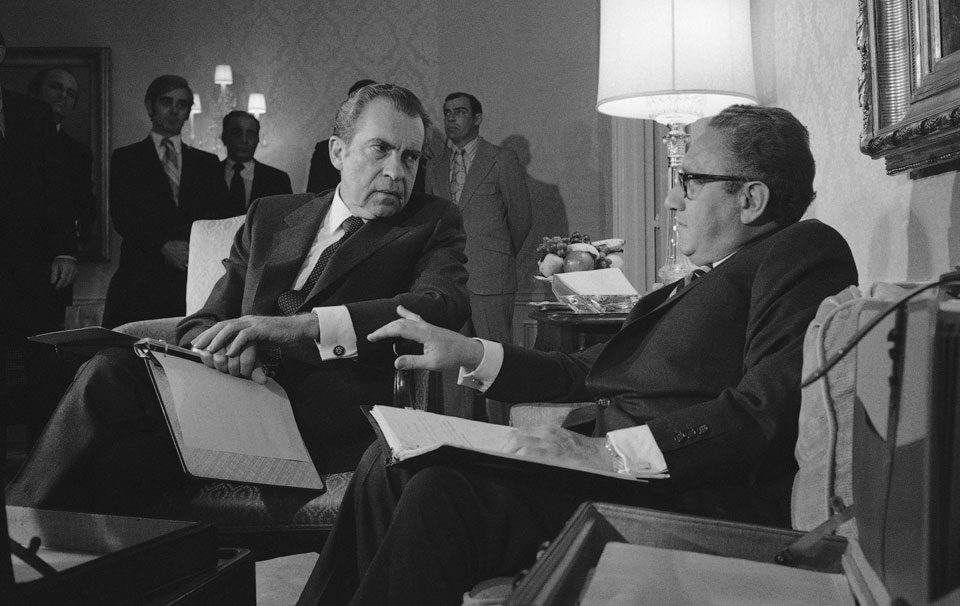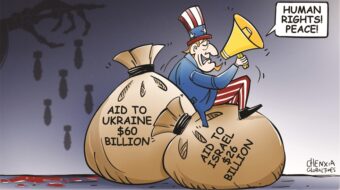
WASHINGTON—Almost from the very minute elected Socialist/Marxist President Salvador Allende took office in Chile in November 1970, Republican U.S. President Richard Nixon and his top officials were scared of his example and his impact—and determined to oust him.
That’s the conclusion that can be drawn from a new group of memos on the U.S. campaign to oust the Chilean president, released this week, on the 50th anniversary of Allende’s inauguration, by the non-profit investigatory National Security Archive at George Washington University in D.C.

The memos and notes show top U.S. officials were scared not just that Allende would successfully implement what they believed were anti-American and anti-corporate policies in Chile, but that other nations in Latin America and Europe would see he had been elected to do so—and follow suit.
So they concocted plans to get rid of the Chilean leader—plans which ultimately resulted in the U.S.-crafted coup against Allende three years later.
The newly released, declassified documents from 1970 show Nixon’s National Security Adviser, Henry Kissinger, plotted in detail with the Central Intelligence Agency on how to destabilize and ultimately overthrow Allende. The CIA even tried to prevent Allende’s nomination before the Chilean election.
Kissinger crafted the details and laid out the alternatives while Nixon took a hard line and then rubber-stamped Kissinger’s recommendations for an economic war against Allende, to topple his government through U.S.-created instability.
“The election of Allende as President of Chile poses for us one of the most serious challenges ever faced in this hemisphere,” Kissinger wrote in a Nov. 5 memo to Nixon—two days after Allende’s inauguration in Santiago.
“If there is any way to unseat A[llende], better do it,” then-CIA Director Richard Helms quoted Nixon as saying, in handwritten notes of a Nov. 6, 1970, top-level meeting when the decision was reached.
Their big fear, the memos and notes reveal, was that other Latin Americans would see the popular election of Allende as a precedent, threatening U.S. corporate interests throughout the region. That would happen elsewhere, too, according to a Nixon-Kissinger phone conversation on Nov. 9, 1970.
“I feel strongly this line is important regarding its effect on the people of the world,” Nixon said then. “If he [Allende] can prove he can set up a Marxist anti-American policy, others will do the same thing.”
“It will have (unintelligible) effect even in Europe. Not only in Latin America,” Kissinger replied in the conversation, one of the documents released by the Archive. It noted Kissinger particularly feared the Allende success’s impact on Italy, which also had a strong Communist Party.
The Nixonites were scared of Allende even before a plurality of Chileans, 36.6%, gave Allende first place in the Sept. 3, 1970 election, just ahead of former President Eduardo Frei of the Christian Democrats and others. That threw the election into the Chilean Congress, and the Christian Democrats joined Allende’s United Front to overwhelmingly elect him to the top job.
Frei told his party, Helms reported, that they should support Allende as the first-place finisher, and they did. He was later ostracized for that decision.
The ultimate overthrow of Allende by his own military Chief of Staff, Gen. Augusto Pinochet, in 1973, and Allende’s death during that coup d’état was a notable episode in the actual Cold War the U.S. waged against the former Soviet Union and its allies.

The CIA was a key player in that struggle, intervening frequently via covert actions to overthrow popularly elected leaders perceived to be opposing U.S. corporate interests.
Top victims of such coups, before Allende, included Prime Minister Mohammed Mossadegh in Iran in 1953 and President Jacobo Arbenz in Guatemala in 1954. The Iran coup reinstated the Shah on his throne, which he held until a combination of six years of fighting leukemia and the popular Iranian revolution forced him out in 1979.
The CIA also conspired to overthrow Congolese independence leader Patrice Lumumba, because of his Pan-Africanism, which opposed U.S. interests. But it was not involved in Lumumba’s 1961 assassination, a 1975 Senate investigation, headed by Sen. Frank Church, D-Idaho, found. U.S. ally Belgium, the former colonial ruler and exploiter of the newly independent nation, was.
And the CIA launched frequent and unsuccessful plots to murder Cuban President Fidel Castro, after first financing and training Miami-based right-wing exiles to invade in 1961, at the Bay of Pigs. In a monumental CIA fiasco, they failed.
In the Allende case, Kissinger crafted the destabilization plan. The documents contain details unavailable before, not even to Church’s committee in its probe of prior CIA covert activities abroad.
The documents, notably a 17-page memo from Helms laying out all the options, cover the period between the failed prevention in mid-1970 of Allende’s candidacy and the Kissinger-Nixon destabilization order days after Allende assumed the Chilean presidency.
The irony, the documents show, is that in the context of the Nixon regime, destabilizing Allende was actually the middle course Nixon and his aides considered.
Nixon’s State Department took a “modus vivendi” line, leaving relations cold but in place while advocating covert aid to the opposition parties, principally, though the memos do not say so, the Christian Democrats.
State had two hopes. One, which it admitted was unlikely, was that Allende would “moderate” his policies. The other was that Allende’s government would lose enough support to lose the next elections, scheduled for 1976.
The most extreme line, an immediate military coup, came from the CIA and Nixon Defense Secretary Melvin Laird. Destabilization fell in between those two alternatives.
Helms’s memo, the most-detailed of the documents, flatly states that several groups within the Chilean elite wanted to prevent Allende’s ascension, but were disorganized and largely leaderless. Each, it seemed, was waiting for the others to move first.
None moved, Helms contended, because, in his words, Chileans were “softened up” by “propaganda” from the pro-Soviet Chilean Communist Party—which advocated a parliamentary path to power—the more-radical Socialists and even the Christian Democrats.
“As a result, the Chileans viewed the coming of Allende with apprehension and unease, but not with the repugnance and gut concern which could have led to action,” Helms’ memo says.
That wasn’t Kissinger’s attitude, however, the newly released documents show.
The key memo, on Nov. 9, from Kissinger’s National Security Council, described the economic destabilization plan in detail. It came three days after the top Nixon officials met in private to discuss what to do about Allende. Even Secretary of State William Rogers, whose agency advocated the softest plan against Allende, wanted “to bring him down,” that Nov. 6 memo says.
Three days later, Kissinger announced to the others that “the president has decided that (1) the public posture of the United States will be correct but cool, to avoid giving the Allende government a basis on which to rally domestic and international support for the consolidation of the regime; but that (2) the United States will seek to maximize pressures on the Allende government to prevent its consolidation and limit its ability to implement policies contrary to U.S. and hemisphere interests.”
Chilean destabilization included banning future economic aid to Chile and having international financial institutions wind up current loans there and blocking further ones. It authorized yanking export credits to Chile which that nation then used to buy U.S. goods.
Destabilization also included lobbying other nations, specifically Brazil and Argentina, to follow the U.S. lead. In 1970, a right-wing military dictator ruled Brazil, while a three-general repressive rightist Argentine junta kept installing and ousting presidents.
“If we have to be hostile, we want to do it right and bring him down,” Rogers said on Nov. 6, just days after Allende became Chilean president. “A stance of public hostility would give us trouble in Latin America. We can put an economic squeeze on him. He has requested a debt rescheduling soon. We can be tough. We can bring his downfall perhaps without being counterproductive.”
The Nov. 6 decision memo to the Departments of State and Defense and the CIA even pondered possible ways to destabilize the market for Chile’s copper, its main export. Director of Emergency Preparedness George Lincoln advocated that, and Nixon at first went for the idea.
But another participant pointed out copper’s world price was already significantly down and if the U.S. unloaded copper from its stockpile, the move would be too obvious—and illegal under U.S. law governing the stockpile. Manipulating the copper market was dropped.

Kissinger later justified to Congress that the Nixon government’s actions to bring down Allende were “to preserve democracy” in Chile. The documents released by the National Security Archive added to others Church’s committee released, show that was a lie. None of the memos and notes contain the word or allude to it.
Before the plotting outlined in detail in Helms’ memo, the CIA’s first anti-Allende try failed in mid-1970, the memos show. Pinochet’s predecessor as military Chief of Staff, Gen. Rene Schneider, refused to order the armed forces to rise against Allende. Doing so would have broken Chile’s democratic history of more than 120 years. Pinochet later smashed that history and ruled for 17 years after his coup.
With CIA aid, Pinochet ousted Allende in Sept. 1973. Reports differ on whether invading soldiers murdered Allende in the presidential palace, La Moneda, on orders or whether he took his own life. Allende’s daughter, later a Chilean legislator, said suicide. His niece said murder.
Investigators’ statistics after Pinochet lost power say his coup plotters killed some 3,400 people. Another 30,000 or so were “disappeared ones,” kidnapped and presumed murdered by the Chilean military and other right-wingers. The probers calculated the military was responsible for 95% of the deaths.

The Center for Justice and Accountability later described “a military death squad known as the Caravan of Death [which] traveled city to city, dragging political prisoners from jail and executing them.” When bodies of 75 victims were found later after Pinochet lost a 1990 election and fled, it was determined all had been tortured.
The death and disappeared figures are probably low. One U.S. newspaper, in Chicago, sent a reporter extremely fluent in Spanish to cover the coup. He would attend the briefings at the U.S. embassy, where the death toll was announced as, say, 30, he later told his family.
Then the reporter would grab a cab to the main cemetery and ask how many bodies they buried after assassinations at the main holding area, a large sports stadium. The reply was 300, not 30. That higher figure went in the paper.
After the coup, Pinochet’s agents extended their operations abroad. On Sept. 21, 1976, Chilean spy agency (National Intelligence Directorate/DINA) operatives killed Pinochet’s most-prominent remaining foe, Allende’s former Foreign minister Orlando Letelier, and his aide, Ronni Karpen Moffitt, while they were on their way to work at the Institute for Policy Studies in D.C. Moffit’s husband of four months was injured.
DINA blew up Letelier’s car as it rounded Sheridan Circle in Washington’s Embassy Row. The blast shook the entire neighborhood. Years later, four DINA operatives were arrested, tried, and convicted of the crime, out of seven originally indicted. Grand juries also looked into indicting Pinochet, but extradition questions and his failing health ruled that out.












Comments